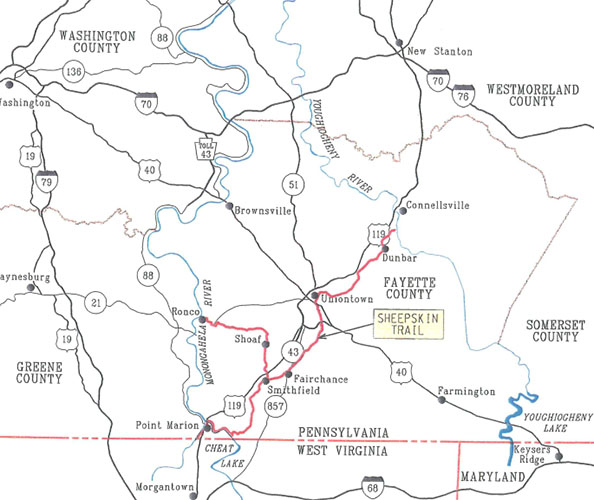Building the Sheepskin Trail
published on May 1, 2019



The National Road Heritage Corridor’s work includes efforts to develop a rich tourism infrastructure that will support the growth and sustainability of that industry, a strong economic driver in Southwestern Pennsylvania. Since beginning operations in 1995, the NRHC has delivered over $13 million in state, federal and private grant funds as well as additional leveraged investments in the region. One of our current projects is the development of the Sheepskin Trail, a 34-mile recreational amenity in Fayette County, Pennsylvania.
As you can see from the map above, the Sheepskin Trail extends from Dunbar Borough down to Point Marion Borough, serving as the missing link that will connect the Great Allegheny Passage, and the Potomac Heritage National Scenic Trail with the WV Mon River Rail-Trail System. The completed trail will offer alternative transportation options for community residents, allowing them to enjoy safe walking and biking paths to school, work, shopping and community parks. It will also allow visitors and residents to experience the outdoor recreation, including fishing and cross country skiing.
About the Trail
The Sheepskin Trail is known as a “rail-trail.” According to theRails-to-Trails Conservancy, “Rail-trails are multi-purpose public paths created from abandoned railroad corridors. Flat or following a gentle grade, they traverse urban, suburban and rural America.” Today, this network consists of more than 10,000 miles of rail-trails across the country. By converting these abandoned industrial rail lines into walk-able, bike-able, and equestrian-oriented trails, we can help link people to parks and the countryside from where they live and work.
This particular rail and future rail-trail was built in the 1890s and served as the Pittsburgh branch of the B&O Railroad. It got its nickname from the older railroaders, who called it the “Sheepskin Line,” because when it first opened the sound of the trains would scatter sheep for miles. The disgruntled herders would then exclaim, “Darn Sheepskinners!” and the name stuck.
The lines were built to meet the needs of the region’s once booming coal and coke industry. In fact, the rail service opened the southern end of the Connellsville Coke Region. Along the proposed trail, travelers will be able to see the remnants of the coke ovens along the route including: Cheat River Coke Works, Ada’s Bottom Coke Works, Atchison Coke Works, and Shoaf.
Community Benefits
This completed trail system is the key to unlock an abundance of recreational, cultural, and heritage opportunities. Travelers will have the opportunity to hike, bike, fish, and paddle, while discovering the rich industrial and historic heritage of Southwestern, Pennsylvania. Below are some of the community benefits and positive effects that the Sheepskin Trail will have on the region:
- Livability: Residents will have alternate transportation options to travel to work or school. They will also have access to more outdoor activities through safe and enjoyable access to the walking and biking paths and waterways.
- Community Development: The trail will connect small “patch towns” and suburbs to the outdoors, connecting the community as a whole and building pride within the region.
- Land Conservation: The Sheepskin Trail and the lands surrounding it will contribute to the preservation and conservation of green space as well as essential woodlands that support the area’s wildlife. The trail will also serve as a significant greenway in our region, linking the Youghiogheny, Monongahela, and Cheat River watersheds.
- Heritage, History, and Culture: The development of the trail will reveal many of the rich historical and environmental assets of Southwestern Pennsylvania. This will convey the value of these resources, encouraging their preservation and conservation.
- Economic Impact: In 2008, after the completion of the Great Allegheny Passage, trail users contributed $40,677,299 to the businesses operating on or around the trail. The Sheepskin Trail has the potential to open to door for similar positive economic impacts by attracting new residents and businesses who want to live, work, play and prosper in this region.
The National Road Heritage Corridor is committed to connecting communities and supporting economic development in Southwestern Pennsylvania. By unlocking this vital community resource, we open the door for endless opportunities for residents and visitors to connect with nature and history and to reap the vast economic benefits the trail will offer. To help make this dream a reality, see how you can become a Friend of the Road.
